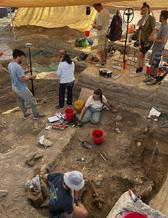An archaeological expedition from the University of Gothenburg recently discovered tombs outside the Bronze Age trading metropolis Hala Sultan Tekke in Cyprus. They rank among the richest ever found in the Mediterranean region. The precious tomb artefacts indicate that their occupants ruled the city, which was a centre for the copper trade in the period 1500-1300 BCE.

"Considering the richness of the grave goods, it is a reasonable assumption that these were royal tombs, even though we do not know much about the form of government practiced in the city at the time. Undoubtedly those buried here were part in the city's government," says Peter Fischer, professor of archaeology and leader of the expedition.
The tombs, located outside the 50-hectare Bronze Age city, consist of underground chambers accessed via a narrow passage from the surface. The chambers varied in size, measuring up to 4 x 5 metres.
More than 500 artefacts
The Swedish Söderberg expedition, which has been excavating in Hala Sultan Tekke near the city of Larnaca on the south coast of Cyprus since 2010, has previously found chamber tombs with valuable grave goods. What distinguishes the newly discovered chamber tombs from those previously excavated is the sheer quantity of artifacts and their superb quality.
"We found more than 500 complete artifacts distributed among two tombs. Many of the artifacts consist of precious metals, gems, ivory and high-quality ceramics."
About half of the artifacts were imported from neighbouring cultures. Gold and ivory came from Egypt. Precious stones, such as blue lapis lazuli, dark red carnelian and blue-green turquoise, were imported from Afghanistan, India and Sinai respectively. The tombs also contain amber objects from the Baltic region.
The tombs were discovered using magnetometers, a type of instrument that can produce images showing objects and structures up to two metres beneath the surface.
"We compared the site where broken pottery had been ploughed during farming with the magnetometer map, which showed large cavities one to two metres below the surface. This led us to continue investigating the area and to discover the tombs."
Woman buried with one-year old
The several well-preserved skeletons in the tombs include that of a woman surrounded by dozens of ceramic vessels, jewellery and a round bronze mirror that was once polished. A one-year-old child with a ceramic toy lay beside her.
"Several individuals, both men and women, wore diadems, and some had necklaces with pendants of the highest quality, probably made in Egypt during the 18th dynasty at the time of such pharaohs as Thutmos III and Amenophis IV (Akhenaten) and his wife Nefertiti."
Embossed images of bulls, gazelles, lions and flowers adorn the diadems. Most of the ceramic vessels came from what we now call Greece, and the expedition also found pots from Turkey, Syria, Palestine and Egypt.
The grave goods also included bronze weapons, some inlaid with ivory, and a gold-framed seal made of the hard mineral haematite with inscriptions of gods and rulers.
"The vast wealth of the entombed individuals came from the production of copper. Nearby mines in the Troodos Mountains produced copper ore, which was refined in the city. This port city then exported the refined metal in large quantities to neighbouring cultures. Copper was an important commodity because, combined with tin, it becomes the hard alloy bronze, which gave its name to the Bronze Age," says Peter Fischer.






